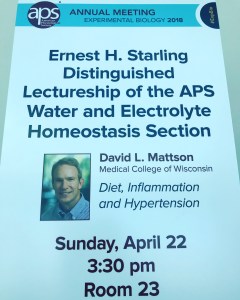
This year a number of abstracts about sickle cell and the kidney caught my attention, having just initiated dialysis on a patient with HbSS. Since the science forces of the universe seemed determined to focus my attention on this disorder, I gave into their wishes.
Hemoglobin (hb), the molecule that carries oxygen to tissues in our body, is composed of two alpha protein chains and two beta chains. In the HbS mutation, a single change in the beta chain changes the structure of the protein so that when oxygen levels drop, it becomes straighter instead of round, stretching red blood cells into a crescent or sickle shape. Abnormally shaped red blood cells are prone to damage (hemolysis) and may clog the smallest vessels in the body, resulting in organ damage and pain.

If a child gets one copy of the HbS gene, then they are a carrier; this condition is also called sickle cell trait and occurs in 1 in 13 African American babies. Most people with trait have no symptoms, although under conditions of low oxygen their disorder may be unmasked. For example, the central part of the kidney (the medulla) has much lower oxygen tension normally. Cells often sickle there and cause damage, so individuals with otherwise asymptomatic sickle trait may not be able to fully concentrate their urine.
If a child gets a copy of HbS from both parents, then they have HbSS, the full-blown sickle cell anemia disease. This happens to about 1 in 365 African American children. These individuals have anemia because the sickling cells don’t last as long as those with normal Hb (3 weeks vs 3 months). The abnormally shaped cells may also impair blood flow to organs cause acute pain episodes, what most people think about with sickle cell disease. In addition, other organs may be damaged by these events, including the brain, heart, lungs, and kidneys.
For more general information about sickle cell disease, including other associated hemoglobin disorders, the NIH has an excellent resource here.
Your ads will be inserted here by
Easy Plugin for AdSense.
Please go to the plugin admin page to
Paste your ad code OR
Suppress this ad slot.
The first poster on my list dealt with KIM-1 (Kidney Injury Molecule 1) as a new biomarker for kidney damage in a humanized mouse model.They followed glomerular filtration rate (GFR) and urinary biomarkers in HbSS mice and genetic controls every 4 weeks for 24 weeks starting at 8 weeks of age. At that starting point, no differences in GFR or proteinuria were demonstrated. By 12 weeks, the HbSS mice had a significant rise in GFR and proteinuria. By 32 weeks of age, GFR was lower in HbSS than Hb AA mice, even as proteinuria climbed higher. Urine biomarkers demonstrated early KIM-1 as a potential predictor of loss of GFR later in the course. Not included in the abstract was a cohort of patients with HbSS, some of whom have developed elevated KIM-1 excretion. This has the potential to drive important translational studies in the future.
The next poster looked at renal cilia in this same mouse model. Ciliary disorders often result in cysts in the kidneys, and patients with HbSS have an increased risk of cyst formation. Kidneys from HbSS mice have reduced ciliary proteins in their kidneys, suggesting reduced numbers or size of cilia in this model. Additional studies applied hypoxic stress to the mice, a maneuver that increased expression of the proteins under study. These experiments are still preliminary, but I would never have guessed that cilia would be a problem in sickle cell kidneys.
The final poster examined the role of Hb uptake in tubular cells in nickels cell disease. Much of this study occurred in vitro, examining what happened to tubular transport when free Hb gets filtered and the tubules reabsorb it. It competes for transport with a number of other proteins, such as albumin and the vitamin D binding protein. Patients with HbSS have reduced red blood cell lifespan and episodic hemolysis, so they do filter higher amounts of free Hb. They also seem to be much harder to make replete with Vitamin D. These basic science observations may help explain some interesting clinical observations, even though these phenomena would seem unrelated at first glance.
Sometimes an abstract just grabs me; this time, three of them jumped me and made me write about them. All were really good science with excellent presenters, and a lot more information than I’ve included here (click the links, people). Best of luck helping us understand this difficult consequence of a fairly common disorder.










